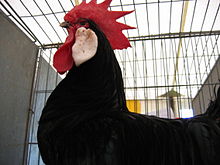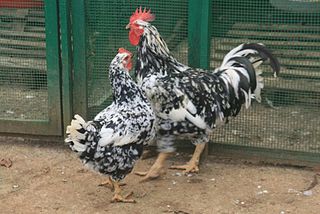
The Pita Pinta Asturiana is a Spanish breed of chicken. It is the only chicken breed indigenous to the principality of Asturias, in north-western Spain.
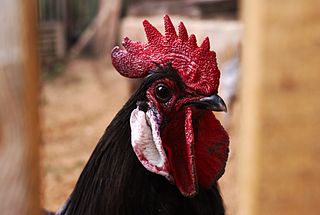
The Blue Andalusian, Spanish: Andaluza Azul, is a breed of domestic chicken indigenous to the autonomous community of Andalusia in south-west Spain. It is distributed through much of the countryside of Córdoba and Seville, and is concentrated particularly in the area of Utrera, which is considered the heartland of the breed. In 2009 the population was estimated at 10000 birds.

Asturian Mountain is a local Spanish breed of cattle named after the Asturias, which possess breeding capacity and docility. They are primarily raised in the east of Asturias, in the north of Spain, particularly in the mountain range of the Picos de Europa, including within the National Park of Covadonga. The breed is also known as the Casina They are beef cattle and one of three breeds used to produce Casín cheese.

The Mallorquín or Caballo Mallorquín is a rare breed of horse indigenous to the island of Mallorca in the Balearic Islands, from which it takes its name. Identification of the breed was begun in 1981 by the Patronato para las Razas Autóctonas de Mallorca. The Mallorquín is listed in the Catálogo Oficial de Razas de Ganado de España in the group of autochthonous breeds in danger of extinction.
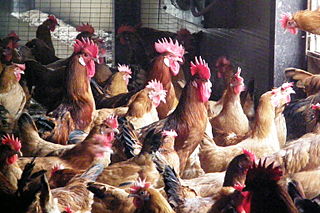
The Catalana, Catalan: Pota Blava, Spanish: Gallina del Prat or Catalana del Prat, is a Spanish breed of domestic chicken. It originates in the area of El Prat de Llobregat in the comarca of Baix Llobregat, in Catalonia in eastern Spain. It may also be called the Catalana del Prat Leonada or Buff Catalana for its golden plumage. The Catalana is a hardy dual-purpose breed kept for both eggs and meat.
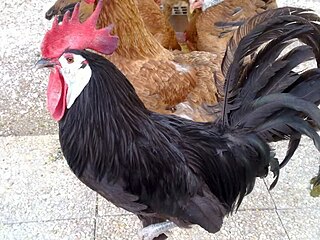
The Spanish or White-faced Black Spanish, Spanish: Cara Blanca or Española Cara Blanca, is a breed of domestic chicken which originated in Spain, but was largely bred to its present type in Great Britain in the eighteenth century. It is an older breed than the Minorca. It is distributed throughout the world, but is rare in Spain.

The Catalan is a breed of large domestic donkey from the historic region of Catalonia, now in north-eastern Spain and south-western France. Approximately 80% of the breed population is in the modern autonomous community of Catalonia, and approximately 20% is in the historic Roussillon region of France.

The Rubia Gallega, Galician: Rubia Galega, is a breed of cattle native to the autonomous community of Galicia in north-western Spain. It is raised mainly for meat. It is distributed throughout Galicia, with about 75% of the population concentrated in the province of Lugo. The coat may be red-blond, wheaten, or cinnamon-coloured.

The Menorquín or Catalan: Cavall Menorquí is a breed of horse indigenous to the island of Menorca in the Balearic Islands, from which it takes its name. It is closely associated with the doma menorquina style of riding.

The Zamorano-Leonés is a breed of large domestic donkey from the provinces of Zamora and León, in the autonomous community of Castilla y León, in north-western Spain. The name derives from those of the two provinces.

The Balearic, Catalan: Ase Balear, Spanish: Asno Balear, is a Spanish breed of domestic donkey indigenous to the autonomous community of the Balearic Islands, in the Mediterranean off the eastern coast of Spain. It is found mainly in Mallorca, the largest island of the group, and also in Menorca, where it was much used for mule-breeding; it is no longer present in the islands of Eivissa and Formentera. Since 2006 it has been officially called the Raça Asenca Balear; it was previously known as the Raça Asenca Mallorquina, and was also referred to as the Ase MallorquÍ, Asno Mallorquín or Mallorquín.

The Castellana Negra or Gallina Castellana Negra is a Spanish breed of domestic chicken. It is a good egg-laying breed, rustic and disease-resistant. It was formerly widely kept and commercially exploited in Spain. Since the advent of imported commercial hybrid layer chickens and the spread of highly intensive chicken farming methods, it has almost disappeared.

The Euskal Oiloa, Spanish: Gallina Vasca, is a breed of domestic chicken from the autonomous community of the Basque Country in north-eastern Spain and south-western France. It is the traditional rural chicken of the area, a rustic dual-purpose breed of Atlantic type, and differs from Mediterranean Spanish breeds such as the Castellana Negra and the Minorca in several respects: it has yellow legs and feet, red earlobes, and lays brown eggs.

The Terreña, Basque: Behi terreña, is an endangered breed of mountain cattle indigenous to the autonomous community of the Basque Country in northern Spain. It is distributed mostly in the provinces of Álava and Bizkaia, with some localised populations in Gipuzkoa.

The Palmera is an endangered breed of cattle from the island of San Miguel de La Palma, in the Spanish autonomous community of the Canary Islands. The cattle are not indigenous to the island, but were brought by European settlers in the fifteenth century. The Palmera derives from the Rubia Gallega breed of Galicia. It is distributed mostly in the municipalities of Breña Alta, Breña Baja, El Paso, Garafía, Los Llanos de Aridane and Villa de Mazo, with small numbers in the municipalities of Puntagorda, Santa Cruz de La Palma and Tijarafe; a few may be found on the islands of Fuerteventura and Tenerife.

The Menorquina is an endangered breed of cattle from the Mediterranean island of Menorca, in the Spanish autonomous community of the Balearic Islands. It belongs to the group of convex-profiled red cattle, whose distribution across the northern Mediterranean region is thought to have followed the path of the Bell-Beaker Culture. It is one of only two autochthonous Spanish breeds of dairy cattle, the other being the Pasiega. The milk is particularly suitable for cheese production, and is used to make Mahón cheese, which has DOP status.
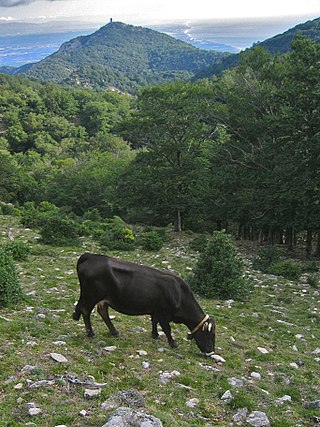
The Albera is an endangered breed of small cattle indigenous to the Albera Massif, which divides Catalonia from France and lies partly in the comarca of Alt Empordà in the Catalan province of Girona, and partly in the comarca of Vallespir in the French département of Pyrénées-Orientales. The cattle are highly resistant to cold, though susceptible to heat, and are well adapted to the steep terrain of the massif.

The Bruna dels Pirineus, Spanish: 'Bruna de los Pirineos', is a breed of cattle from the south-eastern Pyrenees, in the northern part of Catalonia. It derives from cross-breeding of local cattle with Swiss Braunvieh stock imported in the nineteenth century through France and through the Val d'Aran. It is distributed throughout the northern comarcas of Catalonia, Alta Ribagorça, Alt Urgell, Berguedà, Cerdanya, Pallars Jussà, Pallars Sobirà, Ripollès, Solsonès and Val d'Aran. The Bruna dels Pirineus constitutes about 80% of the beef herd of Catalonia.
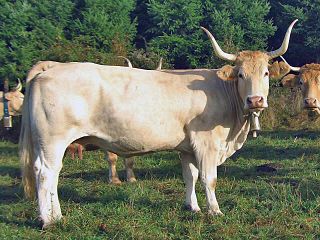
The Pirenaica, Basque: Behi-gorri, is a breed of beef cattle indigenous to the Pyrenees of north-eastern Spain. It is distributed mainly in the autonomous communities of Navarre and the Basque Country, but is present in much of the northern part of the country. It is well adapted to the mountainous terrain and humid climate of the area. It came close to extinction in twentieth century, but is not now at risk.
The Euskal Antzara is a traditional Spanish breed of domestic goose. It originates in the historical Basque Country. It is the only recognised goose breed of that area, and one of two Spanish breeds of goose, the other being the Oca Empurdanesa. It is distributed mainly in the comarca of Enkarterri in the province of Bizkaia, particularly in the areas of Abanto, Balmaseda, Güeñes, Karrantza and Zalla.
